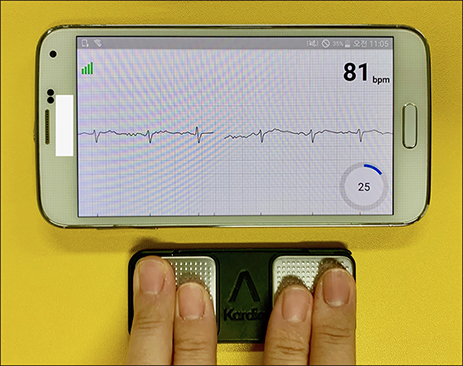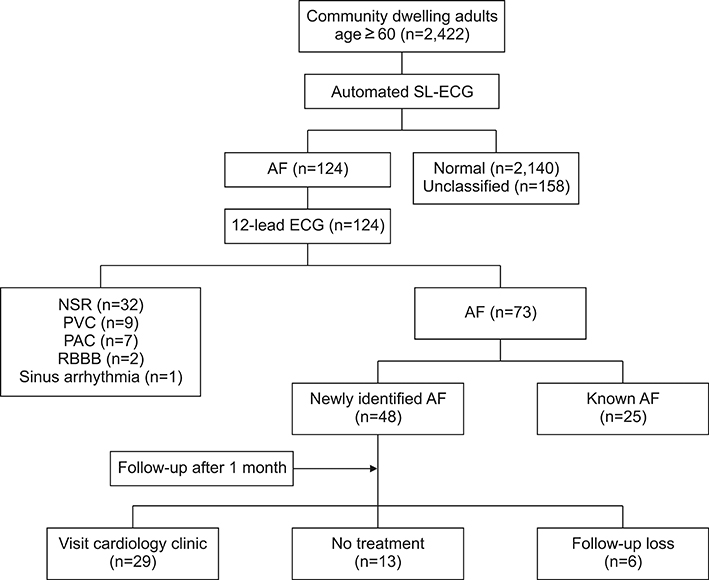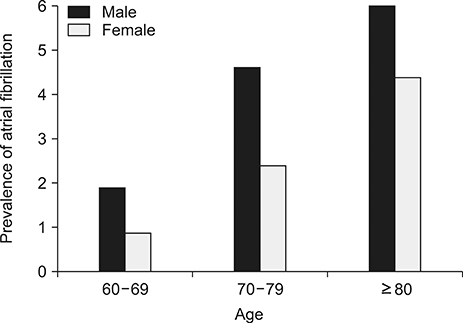Chonnam Med J.
2020 Jan;56(1):50-54. 10.4068/cmj.2020.56.1.50.
Screening for Atrial Fibrillation Using a Smartphone-Based Electrocardiogram in Korean Elderly
- Affiliations
-
- 1Gwangju-Jeonnam Regional Cardiocerebrovascular Center, Chonnam National University Hospital, Gwangju, Korea.
- 2Department of Preventive Medicine, Chonnam National University Medical School, Hwasun, Korea. mhshinx@paran.com
- 3Department of Cardiology, Chonnam National University Hospital, Gwangju, Korea.
- 4Department of Neurology, Chonnam National University Hospital, Gwangju, Korea.
- KMID: 2468146
- DOI: http://doi.org/10.4068/cmj.2020.56.1.50
Abstract
- Atrial fibrillation (AF) is responsible for 10-20% of cerebral infarctions. Several mobile devices have been developed to screen for AF and studies of AF screening have been conducted in several countries to evaluate the applicability of these mobile devices. In this tradition, we conducted a community-based AF screening using an automated single-lead electrocardiogram (SL-ECG). This survey examined 2,422 participants in a community dementia screening program who were aged 60 years or older in the preliminary study, and 5,366 participants at 9 Senior Welfare Centers aged 60 years or older in the expanded study. AF screening was conducted using an automated SL-ECG (Kardia Mobile, AliveCor, Mountain View, CA, USA). AF was confirmed with a 12-lead electrocardiogram in subjects classified as having AF on the SL-ECG. In the preliminary study, of the 2,422 subjects, 124 had AF on the SL-ECG. The prevalence of AF was 3.0% (95% confidence interval [CI]: 2.4-3.8). The positive predictive value (PPV) of SL-ECG was 58.9% (95% CI: 50.1-67.1). Of the subjects diagnosed with AF, 65.8% (95% CI: 54.3-75.6) were newly diagnosed. In an expanded study, of the 5,366 subjects, 289 had AF on SL-ECG. The prevalence was 2.6% (95% CI: 2.2-3.1) and PPV of SL-ECG was 48.8% (95% CI: 43.1-54.5). In this community-based AF screening, we found that AF is underdiagnosed and undertreated. These results suggest that the early detection of AF using mobile devices is needed in Korea.
MeSH Terms
Figure
Reference
-
1. Vital Statistics Division, Statistics Korea. Shin HY, Lee JY, Kim JE, Lee S, Youn H, et al. Cause-of-death statistics in 2016 in the Republic of Korea. J Korean Med Assoc. 2018; 61:573–584.
Article2. Son MK, Lim NK, Kim HW, Park HY. Risk of ischemic stroke after atrial fibrillation diagnosis: a national sample cohort. PLoS One. 2017; 12:e0179687.
Article3. Son MK, Lim NK, Park HY. Trend of prevalence of atrial fibrillation and use of oral anticoagulation therapy in patients with atrial fibrillation in South Korea (2002-2013). J Epidemiol. 2018; 28:81–87.
Article4. Jonas DE, Kahwati LC, Yun JDY, Middleton JC, Coker-Schwimmer M, Asher GN. Screening for atrial fibrillation with electrocardiography: evidence report and systematic review for the US Preventive Services Task Force. JAMA. 2018; 320:485–498.
Article5. Willits I, Keltie K, Craig J, Sims A. WatchBP Home A for opportunistically detecting atrial fibrillation during diagnosis and monitoring of hypertension: a NICE Medical Technology Guidance. Appl Health Econ Health Policy. 2014; 12:255–265.
Article6. Lowres N, Neubeck L, Salkeld G, Krass I, McLachlan AJ, Redfern J, et al. Feasibility and cost-effectiveness of stroke prevention through community screening for atrial fibrillation using iPhone ECG in pharmacies. The SEARCH-AF study. Thromb Haemost. 2014; 111:1167–1176.
Article7. Chan PH, Wong CK, Poh YC, Pun L, Leung WW, Wong YF, et al. Diagnostic performance of a smartphone-based photoplethysmographic application for atrial fibrillation screening in a primary care setting. J Am Heart Assoc. 2016; 5:e003428.
Article8. Chan NY, Choy CC, Chan CK, Siu CW. Effectiveness of a nongovernmental organization-led large-scale community atrial fibrillation screening program using the smartphone electrocardiogram: an observational cohort study. Heart Rhythm. 2018; 15:1306–1311.
Article9. Meschia JF, Merrill P, Soliman EZ, Howard VJ, Barrett KM, Zakai NA, et al. Racial disparities in awareness and treatment of atrial fibrillation: the REasons for Geographic and Racial Differences in Stroke (REGARDS) study. Stroke. 2010; 41:581–587.
Article10. Proietti M, Mairesse GH, Goethals P, Scavee C, Vijgen J, Blankoff I, et al. A population screening programme for atrial fibrillation: a report from the Belgian Heart Rhythm Week screening programme. Europace. 2016; 18:1779–1786.
Article11. Engdahl J, Andersson L, Mirskaya M, Rosenqvist M. Stepwise screening of atrial fibrillation in a 75-year-old population: implications for stroke prevention. Circulation. 2013; 127:930–937.
Article12. Tveit A, Abdelnoor M, Enger S, Smith P. Atrial fibrillation and antithrombotic therapy in a 75-year-old population. Cardiology. 2008; 109:258–262.
Article13. Fitzmaurice DA, Hobbs FD, Jowett S, Mant J, Murray ET, Holder R, et al. Screening versus routine practice in detection of atrial fibrillation in patients aged 65 or over: cluster randomised controlled trial. BMJ. 2007; 335:383.
Article14. Lee SR, Choi EK, Han KD, Cha MJ, Oh S, Lip GYH. Temporal trends of antithrombotic therapy for stroke prevention in Korean patients with non-valvular atrial fibrillation in the era of non-vitamin K antagonist oral anticoagulants: a nationwide population-based study. PLoS One. 2017; 12:e0189495.
Article15. Svennberg E, Engdahl J, Al-Khalili F, Friberg L, Frykman V, Rosenqvist M. Mass screening for untreated atrial fibrillation: the STROKESTOP study. Circulation. 2015; 131:2176–2184.16. Lau JK, Lowres N, Neubeck L, Brieger DB, Sy RW, Galloway CD, et al. iPhone ECG application for community screening to detect silent atrial fibrillation: a novel technology to prevent stroke. Int J Cardiol. 2013; 165:193–194.
Article17. Doliwa Sobocinski P, Anggårdh Rooth E, Frykman Kull V, von Arbin M, Wallén H, Rosenqvist M. Improved screening for silent atrial fibrillation after ischaemic stroke. Europace. 2012; 14:1112–1116.
Article
- Full Text Links
- Actions
-
Cited
- CITED
-
- Close
- Share
- Similar articles
-
- Pharmacological Treatment of Atrial Fibrillation
- Screening and diagnosis of atrial fibrillation using wearable devices
- Pathophysiology and Diagnosis in Atrial Fibrillation
- Atrial Fibrillation Developed after Induction of General Anesthesia in an Elderly Patient: A case report
- Silent Left Large Atrial Myxoma: A Patient with Serial Electrocardiogram Variation





